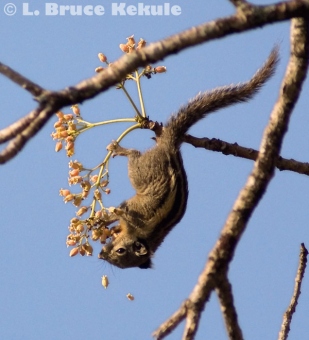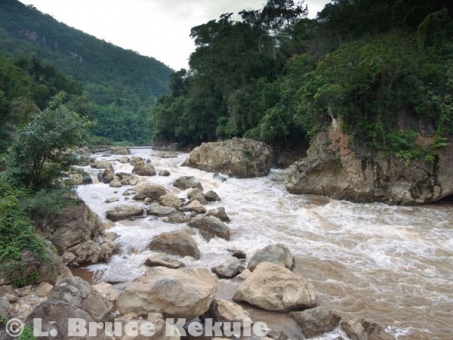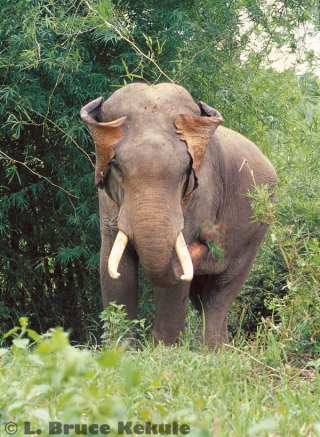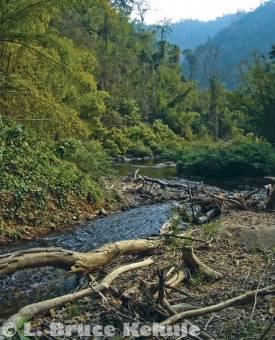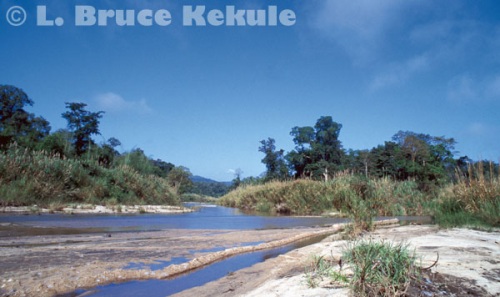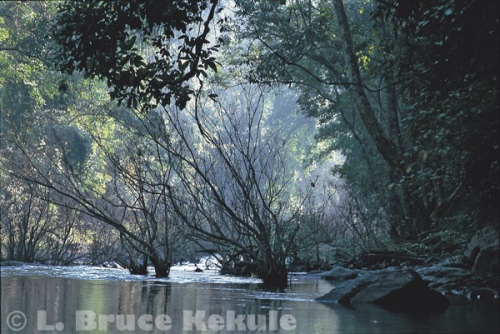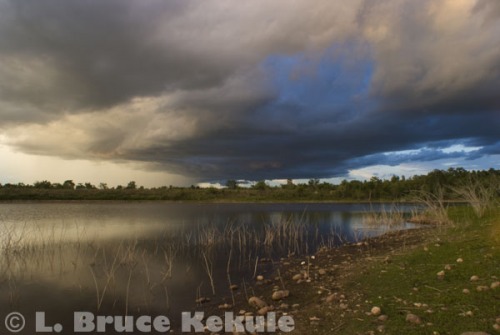Posts Tagged ‘rivers’
Wild Rivers: The Kingdom’s important waterways
Thailand’s rivers: The Khlong Saeng in the South, the Phetchaburi, Huai Kha Khaeng, Mae Klong, and Khwae Noi in the West, and the Mae Ping in the North
Khlong Saeng River in Surat Thani, Southern Thailand
His Majesty King Bhumibol Adulyadej, during his continuing reign of more than 60 years, has always understood the vital importance of protecting and saving Thailand’s forests and watersheds. The concern for natural resources, from the highest mountains down to the deepest marine environments, is a top priority of His Majesty. Royal conservation projects initiated by King Bhumibol continue to flourish in the nation, and play an important role in the preservation of nature.
Bull gaur by the Khlong Saeng River in the late afternoon
Water is the essence of life – two thirds of the earth is covered with this resource. The oceans are the main source of water, and the forests are Mother Earth’s natural filters. Watersheds begin deep in forested mountains that evolved millions of years ago. Streams channel water down to the main rivers, and eventually the sea. Along these waterways – the lifeblood of the nation – many plants, animals and humans undertake their daily lives dependant on water.
The ‘Sea of Fog’ over the Phetchaburi River in Kaeng Krachan National Park
Thailand’s formation began when a group of island continents including China rifted from Pangea, the supercontinent, sometime in the Cambrian-Ordovician period 543 to 443 million years ago. Drifting north on tectonic plates, two smaller continental blocks, the Shan-Thai (Sibumasu) and Indochina meshed together in the late Triassic period, some 220 million years ago. They both eventually crashed into the Eurasian plate to form part of Southeast Asia. Dinosaurs roamed this land, and reptiles flew in its skies and swam in its seas.
Wreathed hornbill not far from the Phetchaburi River
This natural heritage goes back long before dinosaurs evolved on the planet. Trilobite fossils more than 500 million years old have been discovered on islands in the Tarutao Marine National Park off southern Thailand’s Satun province. Other fossilized plants and animals from prehistoric times have also been unearthed throughout the country. Some of the oldest dinosaurs ever found in the world were endemic to northeast Thailand, including a sauropod and a theropod. A vast array of fossil fish, birds, freshwater sharks, turtles, crocodiles, and mammals such as the giant panda, rhinoceros and orangutan have been uncovered. This legacy of evolution is part of the Kingdom’s natural heritage.
The lower Huai Kha Khaeng in the early morning
Continental Thailand and its islands extend over an area of 513,115 square kilometers (198,115 square miles), and at one time, were almost completely enveloped in forest cover with rivers, valleys, plains and mountainous terrain. As the human population grew, these forests began to disappear.
Burmese striped squirrel feeding on flowers at the lower Huai Kha Khaeng
The central lowlands were predominantly deciduous forest, much of which has now been cleared and converted to agricultural land. Teak, pine and hill-evergreen forests covered the mountains of the north, while western Thailand was a mixture of deciduous, dry dipterocarp woodland and semi-evergreen forests. The southern peninsula was mostly wet evergreen, while the northeast and eastern parts of the country were a mixture of dry dipterocarp and lowland dry evergreen.
The Mae Klong River (Mae Nam Choan) in Thung Yai Naresuan Wildlife Sanctuary
At the end of World War Two, 75 percent of the country was forest teeming with wildlife, but that quickly changed as modernization began to take its toll. Barely 30 percent of that forest cover survives today. Long before the existence of roads, rivers provided Thai people with transport and communication links. Not surprisingly, riverbanks were usually the first lowland areas to be cleared.
Common muntjac on the run near the Mae Klong River
After the war, the country was wrapped up in an industrial revolution and the need for electricity was necessary. Hence, hydroelectric power was the choice made as water and forest resources were very plentiful in 1964 when the Yan Hee Dam, now known as the Bhumibol Dam, was the first to be built by the Electric Generating Authority of Thailand (EGAT). It was constructed on the Mae Ping River in Tak province. Since then other dams were quickly developed to keep up with the demand for electric power.
Khwae Noi River in Sai Yok National Park
However, large areas of forest were flooded changing the habitat permanently. Many species of flora and fauna were depleted as water levels rose. Some were able to adapt but it was a long hard struggle for most. With increasing human development, pristine wild riverine ecosystems are now rare.
Tusker bull elephant in Sai Yok National Park
Some fifteen years ago, I embarked on a photographic odyssey along some of the most important rivers in western, southern and northern Thailand. The creatures and ecosystems found in these backwaters have been recorded on film and digital images. Hopefully, these photographs will contribute to the conservation of the nation’s watersheds. As time passes on, these magnificent ecosystems have been degraded. This story aims to serve as a wake-up call to the importance of saving these natural treasures for present and future generations.
Wachirathan Waterfall flowing into the Mae Ping River
For this article, six rivers were chosen: the Phetchaburi, Huai Kha Khaeng, Mae Klong and Khwae Noi in the West, Khlong Saeng in the South, and the Mae Ping in the North. Information and wildlife photographs were collected over 15 years of regular forays into these waterways. The National Parks, Wildlife and Plant Conservation Department (DNP), the Royal Forest Department (RFD) and the Groundwater Resources Department (GRD) under the Ministry of Natural Resources and Environment (MONRE) are responsible for all these protected areas. EGAT and the Royal Irrigation Department (RID) are also involved in management of water.
White-throated kingfisher by the Mae Ping River
Phetchaburi River: It flows all year round from the Tenasserim Range through Kaeng Krachan National Park in Phetchaburi province, some 200 kilometers southwest of Bangkok. This waterway is 170 kilometers long and flows north and then east into the Gulf of Thailand. An agricultural dam, situated at Kaeng Krachan provides the lowland people with water. In the interior, the harmony of life between animals and plants is remarkable, as it is still fairly intact. But this forest is only pristine upriver from the reservoir to the headwaters of the Phetchaburi.
Phetchaburi River in Kaeng Krachan
The lowland areas of the river have been compromised by ethnic tribes people living in several villages within the boundaries of the national park. However, elephant, tiger, leopard, gaur, tapir, Siamese crocodile and many other interesting and rare mammals, birds, reptiles, insects and plants still survive in the interior. More than 400 bird species have been recorded in this national park. In the eyes of some naturalists, this magnificent ecosystem is truly world class.
Lightning over the Phetchaburi watershed
Khlong Saeng River: Down in southern Thailand, it flows from the Phuket Mountain Range to Thailand’s gulf at Surat Thani. Up in the highlands, many tributary streams now flow into a permanently flooded forest in the upper reaches of the Khlong Saeng. Many rainforest creatures like tapir, gaur, elephant, argus pheasant and more are still found in the thick vegetation made up of evergreen forest. Unfortunately, tiger has disappeared, but leopard, clouded leopard, golden cat and marbled cat still thrive.
Khlong Saeng flooded forest
There is a permanent lake 60 kilometers long and dammed near the Khlong Saeng Wildlife Sanctuary headquarters called Chiew Larn, or the Rajaprabha Dam. Many people live on floating rafts and fishing is allowed. However, some fisherman use devious methods like electricity or explosives plus trap-lines that are very detrimental to fish stocks. Also, there are many noisy boats and loads of tourists who visit Khao Sok National Park that shares the lake, and this has an enormous impact on the wildlife and ecosystems in the Khlong Saeng valley.
Huai Kha Khaeng during the late afternoon sunset
Huai Kha Khaeng: A watercourse about 100 kilometers long, it flows south through Huai Kha Khaeng Wildlife Sanctuary, a designated World Heritage Site. The protected area is in Uthai Thani province in the central west. In Thai, ‘huai’ means stream, and ‘kha khaeng’ is strong leg. During the wet season, this stream actually becomes a raging river, but in the dry season it peters down to just a trickle in some places. The wildlife is absolutely remarkable and it is one of the greatest wilderness areas in the world.
Huai Kha Khaeng in the interior
In Southeast Asia, it is the only place where three species of Asian wild bovid occur: gaur, banteng and wild water buffalo. Occasionally, gaur and banteng mingle at mineral deposits. Other mammals include elephant, tiger, leopard, tapir, wild dog, plus many more. About 350 species of birds have been recorded here, including the rare green peafowl. Insect and plant species number in the tens of thousands and many are yet to be discovered.
Mae Nam Choan in Thung Yai Naresuan Wildlife Sanctuary
Mae Klong River: It begins its long journey along the Myanmar border from Umphang Wildlife Sanctuary. This fast and furious river flows south about 140 kilometers through steep rocky terrain through Thung Yai Naresuan Wildlife Sanctuary, also a World Heritage Site, which becomes the Choan River flowing into the Srinagarindra reservoir or upper Khwae Yai River in Kanchanaburi province. The Srinagarindra hydroelectric dam is Thailand’s largest and provides electricity to the national grid. The upper Mae Klong still runs wild today and was saved from damming by an outcry from conservationists around Thailand back in the late 1980s.
Mae Nam Lo not far from the Khwae Noi River
Khwae Noi: It is one of the Kingdom’s best-known rivers. In 1942, the Japanese Army began advancing towards Burma and built what is now known as the ‘Death Railway’ where thousands of Asian laborers and Allied soldiers died building it. The movie ‘Bridge on the River Kwai’ depicted this saga that was screened worldwide. Many of the dead soldiers are buried in a memorial graveyard in Kanchanaburi town, which has a museum adjacent to the cemetery maintained by the Allied War Graves Commission.
Mae Nam Lo further upstream
Another 60 kilometers north at ‘Hell Fire Pass’ in Sai Yok above the Khwae Noi, a museum was funded by the Australian Government in honor of the troops who died there during those horrific times of war. Many wildlife and plant species can still be found along the deepest tributaries within Sai Yok, Khao Laem , Thong Pha Phum and Erawan national parks. The Khwae Noi is dammed at Thong Pha Phum district by the Vajiralongkorn Dam (formally named Khao Laem), which is hydroelectric.
Stormy weather over the Mae Ping River in Tak
Mae Ping River: It is Thailand’s second longest (after the Nan River) that flows from the northern province of Chiang Mai some 590 kilometers south to Nakhon Sawan province in the central plains. People live along most of the river except for a section within Mae Ping National Park, and Omkoi and Mae Tuen wildlife sanctuaries, plus Doi Inthanon National Park further north.
Bhumibol Dam on the Mae Ping River in Tak province
The reservoir behind Bhumibol Dam is 316 square kilometers and created a huge deep water-body due to the terrain of limestone karst the river flows through. The famous ‘Kaeng Soi’ rapids were silenced forever when the reservoir filled-up. Prior to that, many boats and people disappeared in the white water when it was flowing naturally. The lake has been fraught with illegal fishing, poaching and gathering by locals living within and outside the protected area.
Stormy weather over the Phetchaburi River in Kaeng Krachan
The national parks and wildlife sanctuaries these rivers run through need constant surveillance by the DNP. Also, MONRE should implement up-dated laws and regulations to cope with the on-going onslaught of encroachment and poaching. The importance of these rivers cannot be emphasized enough.
Fortunately for Thailand, these waterways provide the lifeblood of the nation even though it can be very destructive at times as the Kingdom is experiencing now with the worst flooding in decades. What was once a massive swamp that drained water into the sea, the Central Plains is now completely carved up and filled in which has created an immense blockage. Over development is the biggest problem with factories, housing estates, elevated highways and rural roads plus a hundred-fold population increase have contributed greatly to the calamity facing the nation at the present.
Reforestation of degraded forests should be the number one priority for the government in areas needed to bring the watersheds back from decline. As it stands now, when heavy rainfall comes naturally, water is not retained but flows full force down the mountains into the lowlands, and many villages and villagers have been washed away in the torrent. Illegal logging continues to plague the country and seems to be getting worse from recent reports that certainly will destroy the watersheds further.
Water management at the dams also needs some serious evaluation. Further, the future building of huge scale dams that destroy large swathes of natural forest are not the answer to the floods like some politicians and construction companies will have you believe. The recent hoarding and then panic release of water at the dams is a point in contention and this needs to be addressed. Cooperation and trust between government ministries and departments is still a long way from being improved and implemented.
The most important element of an intact watershed: does it have hornbills, gibbons, elephants, gaur and other animals that help with seed dispersion and regeneration of the forest? Are these animals protected from excessive poaching and habitat loss? Do they live and reproduce in safety? Can the watersheds retain and release water slowly as nature intended? These are the big questions being asked of the powers-to-be.
Protection and enforcement should be the top priority for all national parks and wildlife sanctuaries that have large rivers and watersheds in them. Unfortunately, old policies governing these will probably be with us for sometime to come. It is essential to understand that all these waterways are under threat, in one way or another.
With no forests, there would be no water, and with no water, there would be no life. Only time will tell if we can adequately protect these vital resources from damaging human encroachment. More active safeguards plus increased budgets are needed, and government regulations should be improved while stamping out corruption. Now this will be a tough nut to crack and can only be curtailed with increased vigilance by the Thai people and agencies concerned, and finally, true prosecution of law-breakers with real jail time. It is the only way forward.







